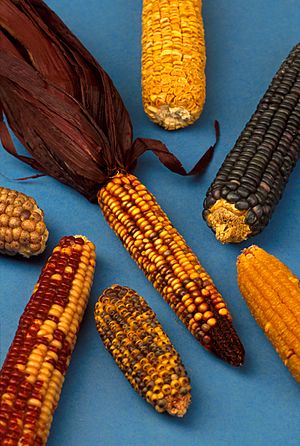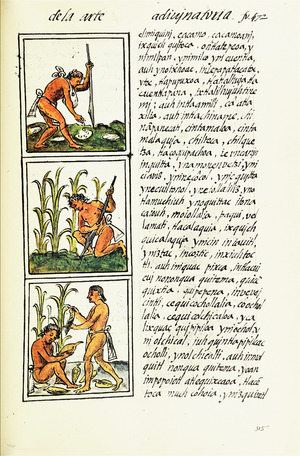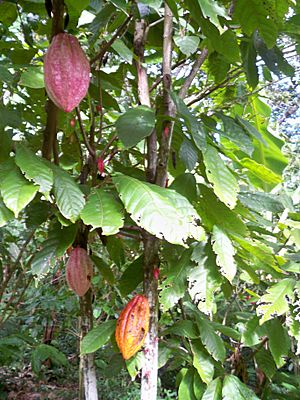Agriculture in Mesoamerica facts for kids

Agriculture in Mesoamerica is all about how people in ancient Mesoamerica (a region in Central America and Mexico) started farming. This happened a very long time ago, between 8000 and 2000 BC.
Before farming, people were nomads. They moved around a lot, hunting animals and gathering wild plants for food. But slowly, they began to plant and grow wild plants near their camps. This was a big change! Growing their own food meant they had extra supplies, especially when hunting was difficult or during dry times. This extra food helped them survive.
Farming might have started on purpose. Maybe people brought wild plants closer to their homes to make them easier to collect. Or, it could have happened by accident, if seeds they ate grew in new places where people lived.
As time went on, growing plants became super important. Having reliable food meant that groups of people could stay in one place and grow larger. Bigger groups needed even more food, so they relied even more on their crops. Eventually, people settled down, focusing on farming and growing plants, with a little hunting on the side. This settled lifestyle allowed villages to grow and led to people doing different jobs and forming more complex societies.
The most important plant in ancient Mesoamerica was definitely maize (corn). Squash and beans were also very important. These three crops – maize, beans, and squash – are often called the "Three Sisters" because they were grown together and helped each other grow.
Important Early Plants
Besides maize, another key crop was squash. Scientists found evidence of domesticated squash from as far back as 8000 BC in a cave in Oaxaca. These early squashes are related to the pumpkins we know today. Another important early squash was the bottle gourd. It was useful for storing seeds or carrying water. Squashes were a great source of protein for ancient Mesoamericans, just like they are for us now!
Beans were another major food source. Remember the "Three Sisters" – maize, beans, and squash? Growing them together was smart because it helped keep the soil healthy and full of nutrients.
Rubber trees and cotton plants were also very useful. Rubber was used to make balls for special Mesoamerican ball games. These games were very important in their culture and often had a ritual meaning. Cotton was used to make textiles (cloth) in bright colors. These colorful clothes show how much the Mesoamerican people cared about how they looked.
Cacao was another culturally important plant. This is where chocolate comes from! Cacao was used to make a special drink for rituals. It was also used as a type of money for trading goods.
These are just a few of the many plants that were important to the ancient people of Mesoamerica. There were many more!
Plants They Grew
Here is a list of some of the plants grown by ancient Mesoamericans:
- Agave* - also known as the Century plant
- Anona – this fruit is also called the "Custard Apple"
- Avocado* - a large, green, egg-shaped fruit with a single seed
- Cacao* - the main ingredient in chocolate
- Cassava* - an edible starchy root, also used to make tapioca
- Chaya – a leafy shrub similar to spinach
- Cherimoya* (fruit)
- Chicle* (Manilkara chicle) – sap used to make chewing gum
- Chili peppers* - many different kinds
- Copal – incense used by the Maya for religious practices
- Cotton* - a plant used mainly to create textiles
- Epazote (Dysphania ambrosioides) – an aromatic herb
- Guayaba* - guava fruit
- Huautli* (Amaranthus cruentus, Amaranthus hypochondriacus) – a type of grain
- Jícama* (Pachyrhizus erosus)
- Maize* - developed from wild grasses in southern Mexico
- Mamey sapote* (Pouteria sapota) – a fruit
- Mora (Rubus blackberry)
- Nopales* - stem segments of Opuntia species, like the prickly pear cactus
- Papaya* (Carica papaya)
- Pineapple – widely grown
- Pinto bean - a "painted" or "speckled" bean; traditionally planted with maize and squash to help the soil
- Squash* (Cucurbita spp.) – pumpkins, zucchini, acorn squash, and others
- Strawberry (Fragaria spp.) – various types
- Sunflower seeds – grown in Mexico and Peru for thousands of years
- Tobacco* - a dried leaf used for trade and peace-making
- Tomato* - a red, berry-type fruit
- Tunas* - fruits of Opuntia species, also called the prickly pear
- Vanilla – orchids grown for their culinary flavor
* An asterisk means the English or Spanish word comes from a native language word.
How They Farmed

One big challenge for farmers in Mesoamerica was the limited amount of good land and the poor quality of the soil. To deal with this, they used two main methods:
- Leaving fields fallow: This means letting a field rest for a period of time in a farming cycle called a milpa cycle. This helps the soil get its nutrients back.
- Slash-and-burn techniques: This involves cutting down and burning plants in an area to clear land and add nutrients to the soil from the ash.
Many of the Maya people grew their food in special gardens called pet kot. These gardens were named after the low stone walls that often surrounded them.
The oldest corn cobs ever found were in a cave in Oaxaca and date back to 4300 BC. Maize was developed from a wild grass called teosinte. Maize was super important because it could be stored for a long time, ground into flour, and easily provided extra food. It was so vital that it appeared in their myths, art, and rituals.
The native people of Mesoamerica also used irrigation to water their crops, similar to other ancient farming societies. However, Mesoamerica has rougher land than places like the Fertile Crescent. So, irrigation was less effective there than other methods like terraced farming and slash-and-burn.
Slash-and-burn is a type of `extensive farming`. This means it uses less work to take care of the land but needs a larger area. In contrast, `intensive agriculture` needs a lot of work but produces more food from the same amount of land. Intensive farming is better for people who live in one place all the time.
See also
 In Spanish: Agricultura en Mesoamérica para niños
In Spanish: Agricultura en Mesoamérica para niños


